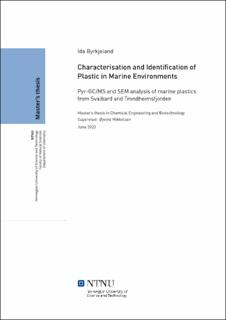| dc.contributor.advisor | Mikkelsen, Øyvind | |
| dc.contributor.author | Byrkjeland, Ida | |
| dc.date.accessioned | 2021-09-28T18:27:06Z | |
| dc.date.available | 2021-09-28T18:27:06Z | |
| dc.date.issued | 2020 | |
| dc.identifier | no.ntnu:inspera:52692076:35312915 | |
| dc.identifier.uri | https://hdl.handle.net/11250/2785410 | |
| dc.description.abstract | Føremålet med denne masteroppgåva var å gje tilskot til forskingsfeltet innanfor plast ved å utvikle ein metode for å identifisere og karakterisere plastavfall frå strender, i tillegg til å undersøkje korleis forskjellege polymerar forvitrar i det marine miljøet.
Feltarbeid vart utført på fire forskjellege strender på den arktiske øysamlinga Svalbard. Plastavfall frå strender vart samla og visuelt skildra ved type og utsjånad. Dei fleste av prøvane var bitar (65%) og tau (23%). Dei vanlegaste fargane var kvit (27%), grøn (21%) og blå (18%). I tillegg vart det utført prøvetaking av mikroplast på strendene, ved å sile sand frå fleire tifeldige stadar på strendene. Det vart ikkje funne noko mikroplast ved denne metoden.
28 av dei totalt 169 plastprøvane vart vidare analysert ved bruk av pyr-GC/MS, der 21 av dei 28 prøvane vart identifisert som høg-densitets polyetylen, og dei attverande sju som polypropylen. I tillegg vart overflatemorfologien studert ved bruk av SEM. SEM-bileta avdekkja nedbrytingsteikn som sprekker, brot, spor, groper og flass. Grunna få prøvar er det vanskeleg å seie noko om samanhengen mellom polymertype og nedbrytingsprosess. Fleire prøvar bør analyserast for å kunne seie noko sikkert rundt dette.
SEM vart også brukt til å studere overflata av kjende plastprøvar som har vore plassert i Trondheimsfjorden i 19 veker. Desse bileta viste høgt nærvær av biofilm. Bruken av pyr-GC/MS og SEM vart funne til å vera ein lovande kombinasjon av teknikkar for å studere plastavfall frå strender. Pyr-GC/MS lukkast med å identifisere alle prøvane ved ein pyrolysetemperatur på 700°C. I tillegg kunne teknikken undersøkje plasten for additiver og adsorberte miljøgifter ved ein lågare pyrolysetemperatur (350°C). Dette avdekkja nærvær av diiso-oktyladipat, dietylftalt og dikloranilin. Likevel er dette ein tidkrevjande teknikk som bryt ned prøva under analyseringa. FTIR og Raman spektroskopi er to andre teknikkar for identifisering av polymerar, som ikkje bryt ned prøven. TEM er ein annan potensiell teknikk for undersøking av plastnedbryting, som gjev 2D-bilete av overflata. SEM har ein fordel over TEM ved at teknikken gjev 3D-bilete, noko som tillèt undersøkjing av partiklar på overflata. | |
| dc.description.abstract | The aim of this thesis was to contribute to the field of plastic research by developing a method for plastic beach debris identification and characterisation, in addition to investigate how different polymers weather in the marine environment.
Field work was carried out at four different beaches located at the Arctic archipelago Svalbard. Plastic beach debris was collected and visually described by type and appearance. The majority of the samples were fragments (65%) and ropes (23%). The most common colours were white (27%), green (21%) and blue (18%). In addition, sampling of microplastics from the nearby beach was carried out, sieving sand from several random spots on the beaches. No microplastic was found using this method.
28 of the in total 169 plastic samples were further analysed using pyr-GC/MS, where 21 of the 28 samples were identified as high-density polyethylene and the remaining seven as polypropylene. In addition, the surface morphology was studied using SEM. SEM pictures revealed degradation signs such as cracks, fractures, grooves, pits and flaking. Due to few plastic samples, it is difficult to say if there is a connection between polymer type and degradation process. More samples should be analysed to say anything certain regarding this.
SEM was also used to study the surface of known plastic samples which had been placed in the Trondheimfjord for 19 weeks. These pictures showed high presence of biofilm. The use of pyr-GC/MS and SEM was found to be a promising combination of techniques for studying plastic beach debris. Pyr-GC/MS successfully identified all samples at a pyrolysis temperature of 700°C. In addition, at a lower pyrolysis temperature (350°C), the technique allowed for investigation of additives and adsorbed environmental pollutants in the plastic. This revealed presence of diisooctyl adipate, diethyl phtalate and dichloroaniline. However, it was a time-consuming technique which destroys the sample during analysis. FTIR and Raman spectroscopy are two other non-destructive techniques for identifying polymers. TEM is another potential technique for investigating degradation of polymers, providing 2D pictures of the surface. SEM has an advantage over TEM by capturing 3D-pictures, allowing for investigation of particles on the surface. | |
| dc.language | eng | |
| dc.publisher | NTNU | |
| dc.title | Karakterisering og identifisering av plast i marine miljø | |
| dc.type | Master thesis | |
